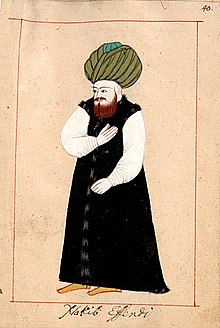
Seyyid Emir Mehmed Pasha (Turkish: Şerif/Seyyid/Emir Mehmed Paşa), known by the epithet "al-Sharif" among his Arab subjects, was an Ottoman statesman who served as defterdar[1] (finance minister) (1589–1593, 1595), Ottoman governor of Egypt (1596–1598),[2][3][4] and Ottoman governor of Damascus (1599–1600).
He was a descendant of Hussein ibn Ali, earning him the epithet "sayyid." While he was the governor of Egypt (with the title beylerbey, often known as viceroy), he was reportedly a frequent visitor of the Al-Hussein Mosque in Cairo.[2] In 1599, he became a vizier.[1]